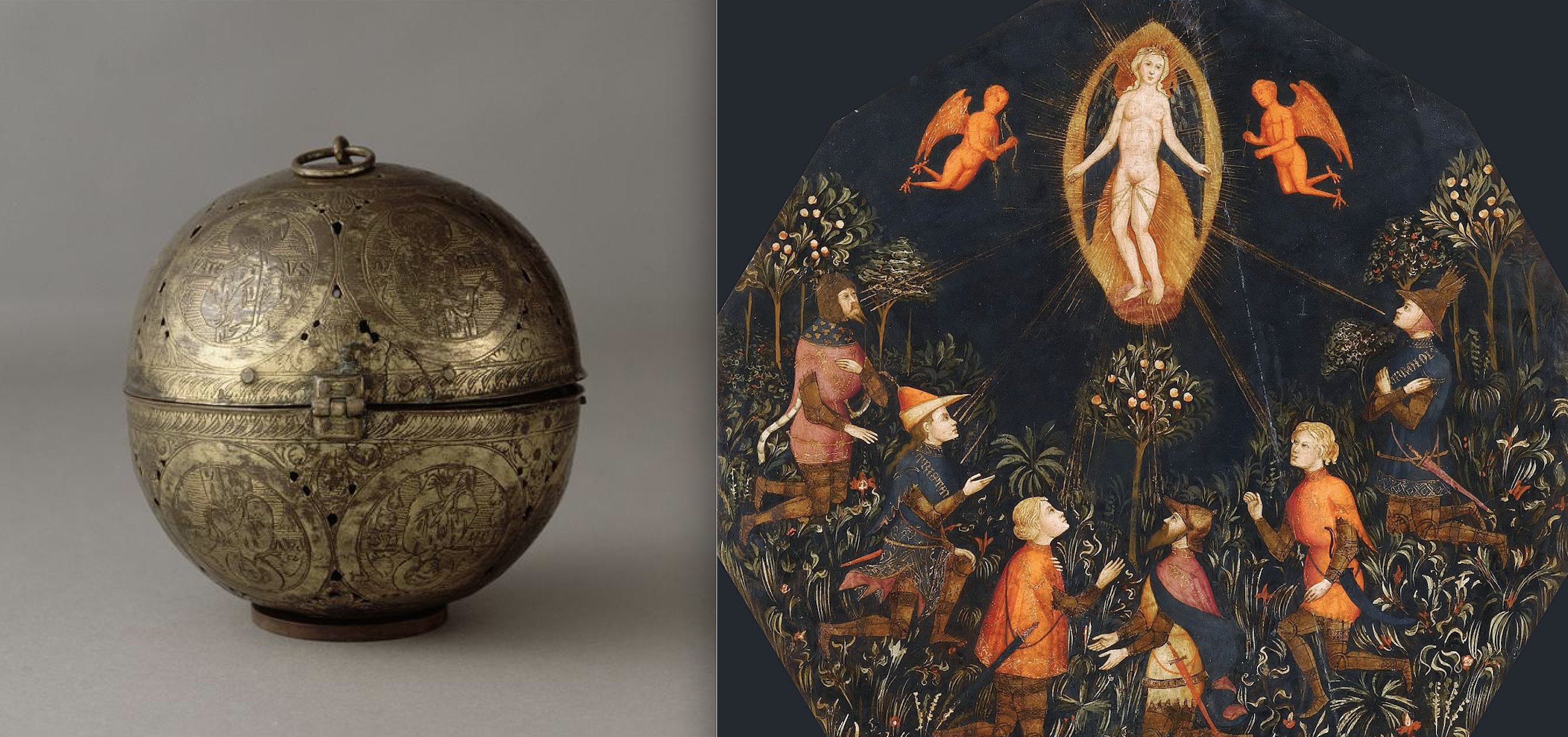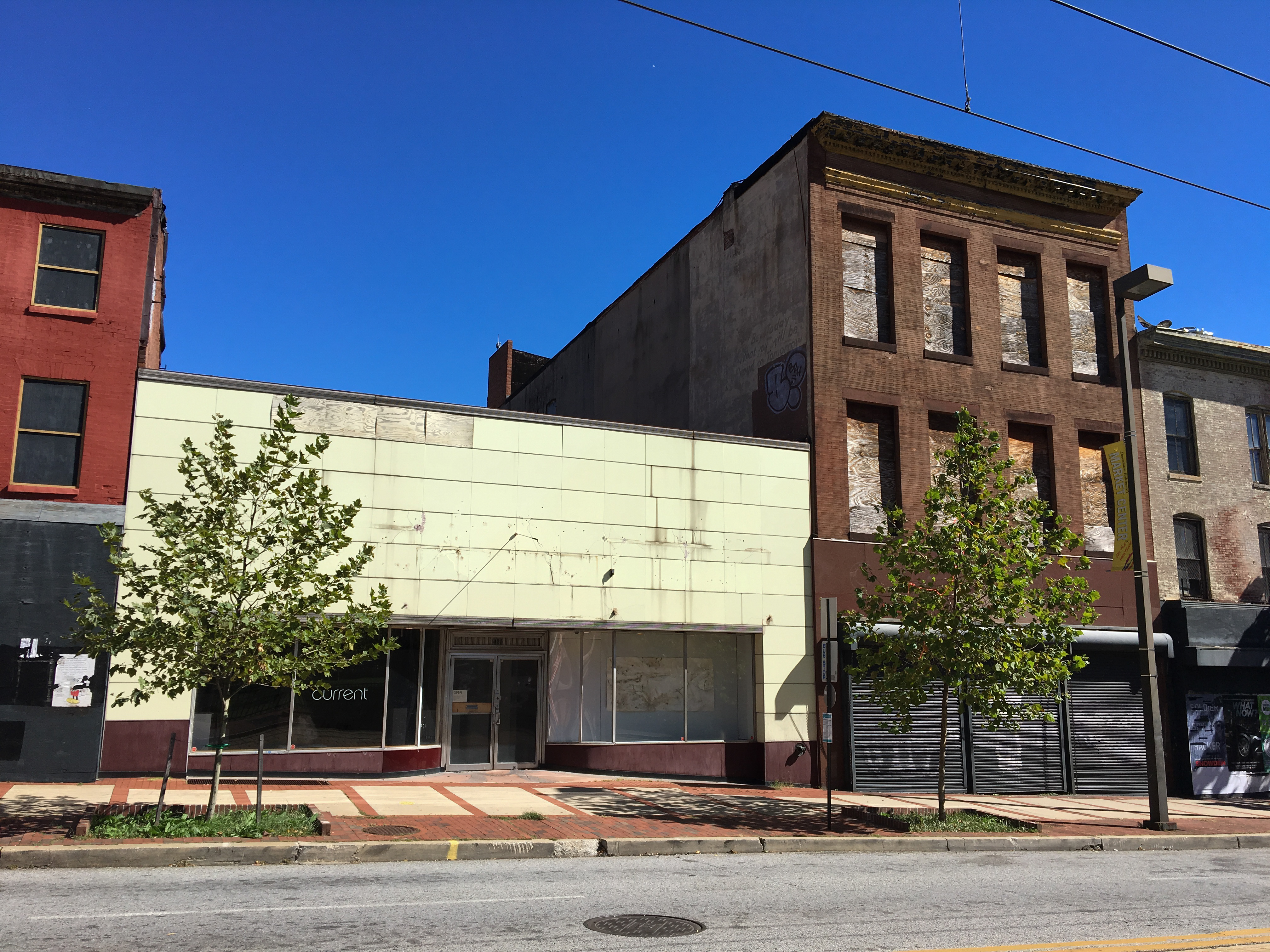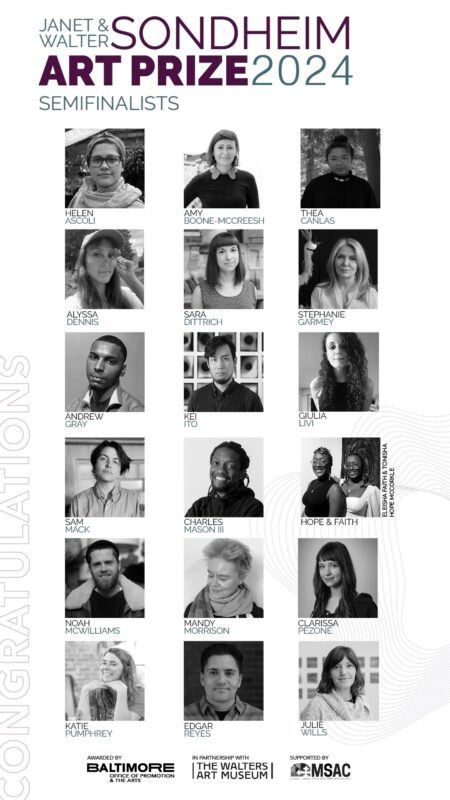Talking to Current Space About Buying their Forever Home by Michael B. Tager
Current Space is a local arts collective that is “committed to showcasing, developing, and broadening the reach of artists locally and internationally.” After eleven years of temporary residences in city-owned buildings, Current is turning a new page and is purchasing their space from the city.
Co-Director Michael Benevento, along with some of his colleagues at Current, explains how they’ve worked together to keep the arts space going and how finding a permanent home will help artists to achieve their goals.
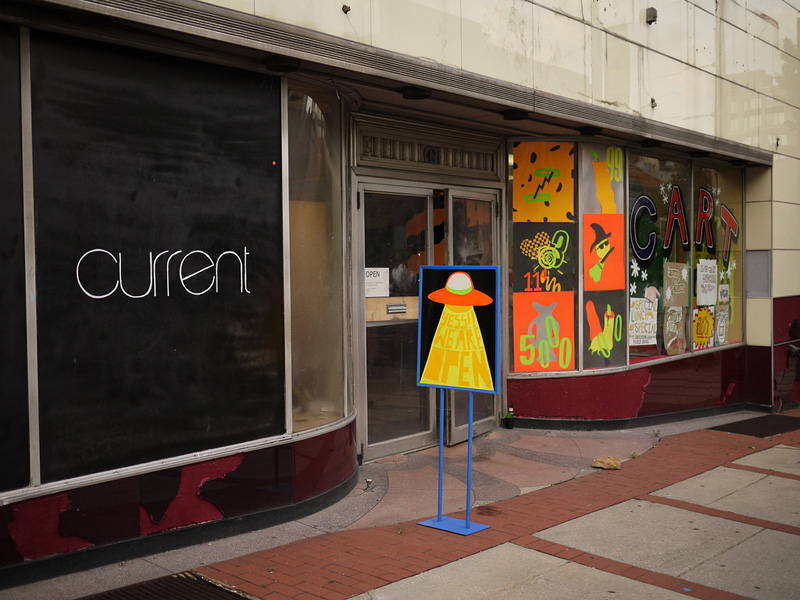
Can you talk a little about what it is Current Space actually is?
Current Space is a volunteer and artist-run gallery, studio, and performance space. Our first show was in January of 2005. Presently we have two gallery spaces that typically change out monthly along with outdoor programing, studios, a darkroom and screen printing facility.
Over the past 11+ years, Current has been a space for many local and international artists to experiment, explore, brainstorm, and exchange ideas. We show a diverse range of works, and intentionally disrupt any trends in our exhibition programming. We also accept proposals for group exhibitions, curatorial projects, solo shows, studio visits, performances, concerts, lectures, poetry readings, screenings, new project ideas, flea markets, workshops, whatever.
We are very excited right now, after 11 years of occupying different blighted blocks of Baltimore, we are in the process of gaining ownership of our building and expanding into the building south of us.
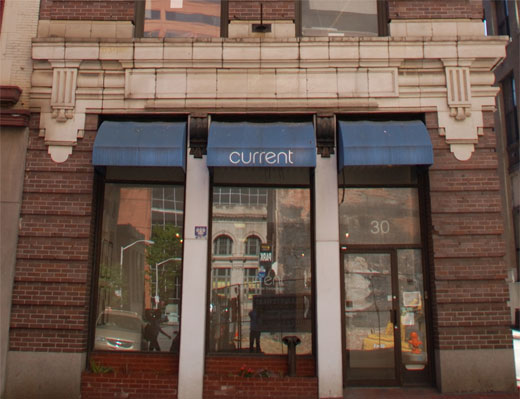 Current’s original space at 30 S. Calvert Street
Current’s original space at 30 S. Calvert Street
Of course you’re excited! It’s very exciting. We’ll come back to that. How did Current Space get started?
In November of 2004 Current Space occupied 30 S Calvert through a call that Baltimore Development Corporation (BDC), Baltimore Office of Promotion and the Arts (BOPA), and Downtown Partnership of Baltimore (DPOB) put together to occupy the building, rent free, till demolition.
This was supposed to only be a six-month lease, awaiting demolition for a large development project, but we were there for over five years before we had to move out to make way for demolition. I had to assist in the demolition progress by touring someone from BDC through the building so they could be familiar enough with the space to lead demolitions crews around. The demolition never happened and the building sat vacant for over five years before it was finally sold and renovated.
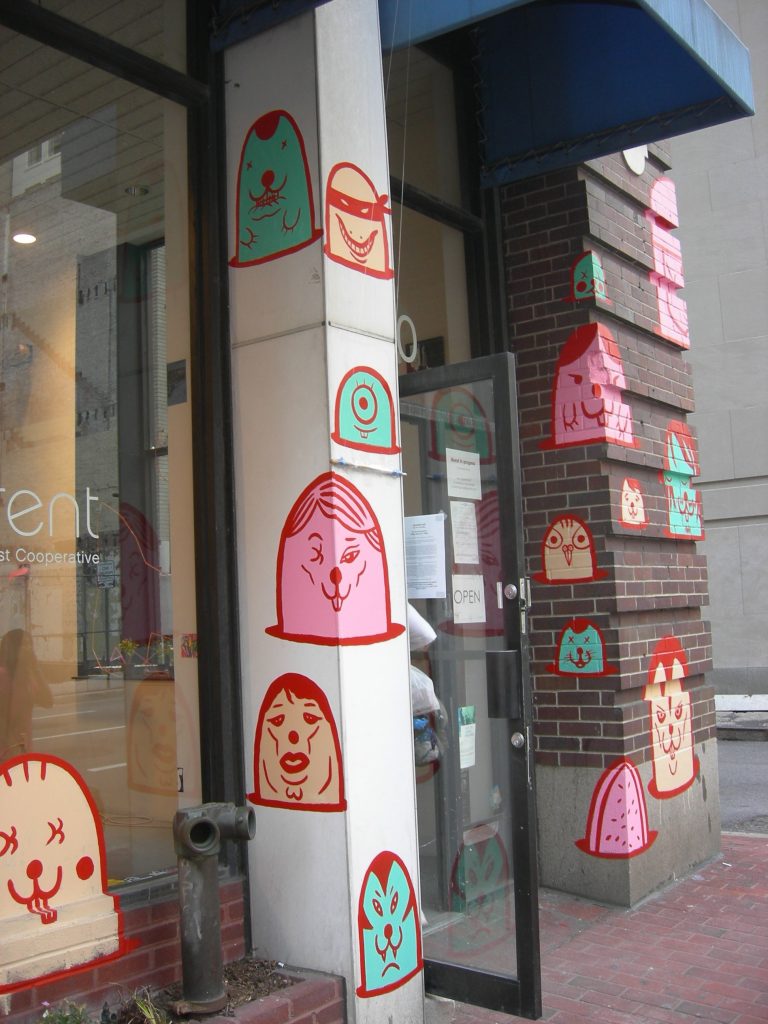 Andrew Liang’s mural on the facade of the original Current Space
Andrew Liang’s mural on the facade of the original Current Space
In 2009 we moved out of 30 S Calvert Street and into storage in the rear of Mike Shecters’ North Avenue Market, which he generously provided for free. With the support of a lot of friends, we relocated projects and equipment, along with any building salvage that would be useful in establishing a new home. We were there for about nine months, making a giant Wack-a-Mole game and curating shows off-site.
In order to operate a gallery and affordable studios, we knew we needed a lot of space for cheap or free. We looked at privately-owned and city-owned vacant buildings, ranging from unaffordable short-term leases to varying degrees of rotting interiors. Finally, John Thompson, who worked at the BDC at the time, showed us 419-421 N Howard St, which had been vacant for only a year.
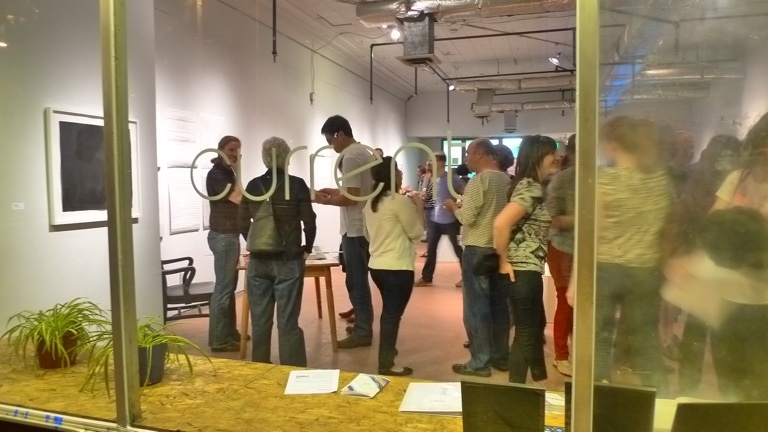
It was previously inhabited by a temp agency, and (according to the breaker box) some sort of military recruitment center. The building needed a lot of work but was usable and we were able to secure a similar short-term, rent-free lease with the city. We were responsible for all repairs, improvements, and operating costs. It’s been a battle—fighting off nature from reclaiming our building—from roof repairs to a ruptured underground sprinkler pipe inducing a sink hole.
However, many of the buildings around us were not as lucky. Over the past 6 years that we’ve been at 419-421 N Howard, we’ve felt the ground shake from the floors collapsing in neighboring buildings. A couple doors over, the elevator shaft spilled into the alley. A couple of the buildings had squatters, but the majority [of buildings] are in such bad condition that even squatters couldn’t utilize them.
Last year BDC put out a Request for Proposal (RFP) for developers to bid on all the city-owned properties on our block, which included our space. Most of the block has been vacant and blighted for decades. We initially didn’t think there would be much demand for the area until a number of cranes sprouted up. I had to lead tours of our building to prospective developers, architects, and house flippers.
We knew we would need to apply to the RFP if we didn’t want to be displaced again. With the help of Marian Glebes, Julianne Hamilton, Fred Scharmen and a lot of community support we were able to get an application submitted. The BDC has actually been very supportive, they said keeping us in our building and expanding the programing in the courtyard into an indoor-outdoor beer garden was a “slam dunk!” We would also be adding a lot of additional studios.
 Bingo night in Current’s back yard
Bingo night in Current’s back yard
That’s awesome. How will this purchase change how you will conduct business?
One major change is our relationship with the city. The city went from possibly kicking us out any day to actually requiring us to operate the space as part of our contract on the building—which is pretty awesome. This switch in dialogue is huge and hopefully will create a positive model for the city to replicate.
We have always been a volunteer-run space. This expansion will allow us to employ people, including ourselves, so we can focus on the space and hopefully not have to work a bunch of other day jobs.
All this will be an expansion of what we are already doing. Right now we have two gallery spaces that typically change out monthly along with outdoor programing in our courtyard, thirteen studios, a darkroom and screen printing facility.
We’ll also be expanding into the building next door, but it has major water damage and sections have collapsed from roof to basement. We will be cutting a big hole in the side so that the ground level can become an expansion of the programing we do outdoors, creating an indoor-outdoor beer-garden art-bar/performance venue. The basement and any floors we are able to salvage will become additional studio space.
The bar element will create a gathering space and help subsidize the studios and gallery. We are very conscientious of not over-building though. Right now we offer studios ranging from $100 – $300 depending on size—it is our priority to keep the studios affordable.
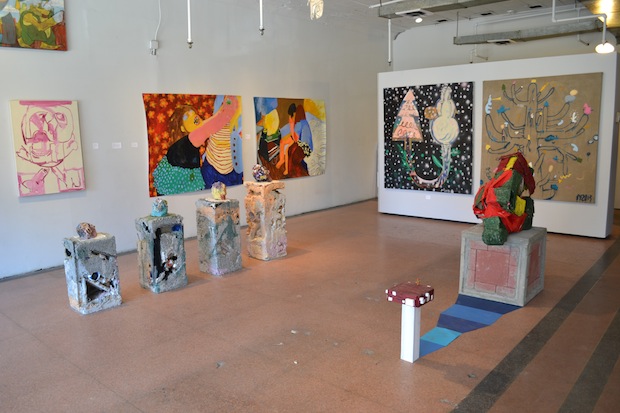
That sounds like a big process, though hopefully sustainable. What do you hope changes for you and for Current Space?
Personally, I hope I’ll be able to spend more time organizing shows and making art, rather than learning how to be a developer.
I’m very excited about what the arts complex will become. I’ve been inspired by the propped-up colonial buildings in old Panama City—the reuse of old warehouses and mansions in New Orleans and Paris. We are seeking out other examples of adaptive reuse and recently went on a research trip to Copenhagen, Berlin, and the ruin bars of Budapest.
That sounds like a lot of fun, looking at reclaimed wreckage. You’re also sort of talking about revitalized areas, much like Bromo Seltzer Arts District is being revitalized by being designated as such. How are arts districts helping artists create sustainable and longer lasting professional spaces?
Designating the area as an arts district gave a name for the density of cultural activity that was already happening in the area. This naming however has made it easier to discuss future growth, proliferation, and opportunity for cultural spaces in the district. Bromo is also a non-profit, so it has the ability to create financial opportunities for artists through fiscal sponsorships, re-granting, or commissioning projects.
Additionally, the district has a staff whose job is to figure out how to support artists and cultural spaces in the district. Priya Bhayana did a great job as the former director and we look forward to working with Stephen Yasko in the future.
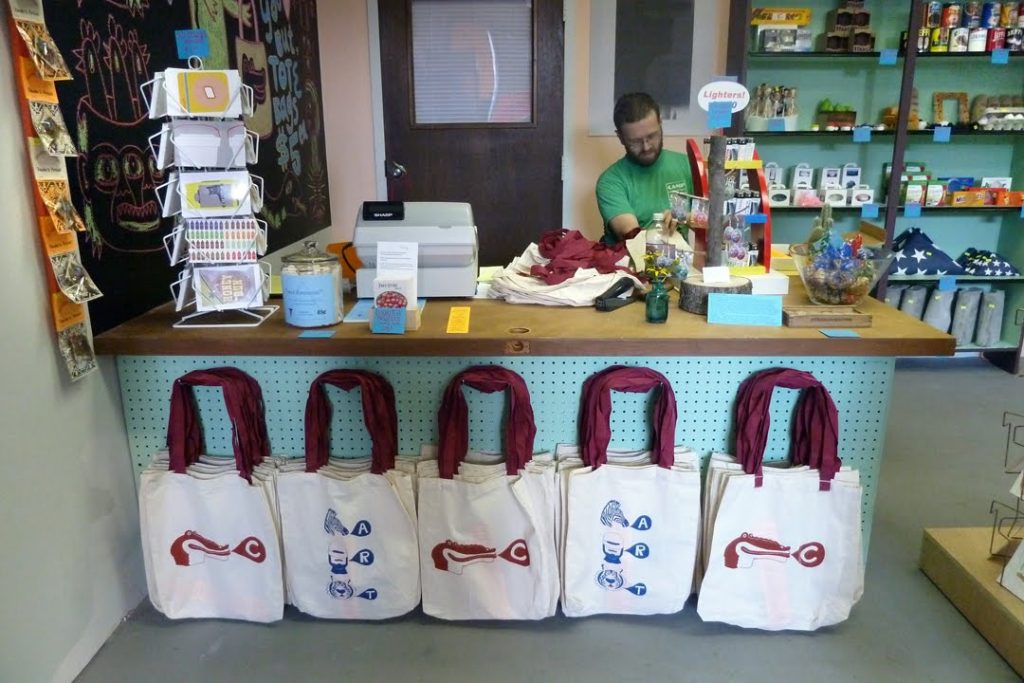
How does working within an arts district affect you?
Why do people choose to live in one city vs another? I think jobs, cost of living, and culture. Most artists I know are partially employed so they can still have time to produce art. However without full time employment or assets, most artists are forced to rent spaces – making them vulnerable to eventually getting priced out of their neighborhood.
This is our second location—we’ve already had to relocate, re-establish, and re-buildout. By owning the space we can ensure that it can’t be taken away, which allows us to invest in the space and plan further into the future. Artists can get studios and not worry about having to move out because our building was taken away. By physically owning a portion of the neighborhood we have a vote in how it’s shaped over time rather than just being pushed out when someone else can offer more rent. I hope our success can help create a positive model for this city and other cities to replicate for art spaces.
The low cost of living has made Baltimore a hotspot for art and music production. People generally stay for the community or leave for the hopes of economic opportunity elsewhere (and sometimes move back). The art production is here; it just needs financial support and resources.
One unique thing about [Baltimore and] the Bromo district is that it has lots of large vacant beautiful historic commercial buildings, so there is a lot of room for development without displacing anyone. I just hope the infill of the neighborhood embraces and includes the African-American and arts communities that already exists here, and preserve the historic character of the neighborhood.
Bromo Arts district has seen some movement in artist-owned spaces. You and your colleagues are currently in the process of purchasing your building. Why?
We want to stay and create a space to enable other artists to stay in the neighborhood. When we first moved to the area we were an art space in a cluster of vacant blighted blocks kind of close to the H&H building and the 14 Karat Cabaret. Over the past six years the area was designated an arts district—lots of new galleries popped up along Franklin St—MAP, Open Space, Springsteen, Terrault, the Contemporary, and the Everyman Theatre relocated into the neighborhood – Platform and Michael Farley/Ryan Mitchell bought buildings on Mulberry.
We’re very excited about Le Mondo, the theater complex opening across the street. Within the last year a handful of new mixed use housing developments have also been built—along with higher end coffee shops and restaurants. These combined resources are likely to attract people with higher financial capacities than a lot of the artists in the area. We want to make sure that the artists still have a place in the arts district as it develops. Ownership will empower us to stay and grow and provide a cultural hub in the district.
 “Here to Stay” detail from Andrew Liang’s mural on the original Current facade
“Here to Stay” detail from Andrew Liang’s mural on the original Current facade
What kind of support community-wide has Current Space received, both monetarily and in-kind? What’s needed now?
We received a lot of community support letters, which strengthened our application for the buildings and was very encouraging for us as well. Beach House, Future Islands and Dan Deacon have offered to play benefit concerts and many visual artists have offered to donate artworks for fund raising efforts, along with a lot of pro bono and low bono professional services. Doreen Bolger, Gary Kachadourian, Andrew Shenker and others have given us a lot of helpful guidance during the process. BOPA, DPOB, TRF, Bromo and Brian Greenan at the BDC have all been very supportive as well.
The City of Baltimore will be selling us the buildings for one dollar each. Our building is in fair condition because we have already invested a lot of time and money maintaining it, but 417 is actively caving in and would likely need upwards of a million dollars worth of work to get the first floor functional and a roof. In addition to loans, we are working on applying for city, state, and federal resources including a Maryland state grant called Project C.O.R.E. which is for projects that remove city blight through stabilization or demolition. None of the grants are guaranteed, but hopefully we’re a strong candidate since we’re on a downtown historic block full of blight, along a major transit corridor and in an arts district.
We were recent recipients of the Contemporary’s Grit Fund, which is funded through the Andy Warhol Foundation and BOPA’s Freefall grant to supplement our programing costs. BETON art space and PB43 in Copenhagen transported Andrew Liang and I, and hosted us in a shipping container residency space to attend Copenhagen Art Week, explore other art spaces, meet other artists and give a lecture about Current Space – this was funded through the Danish Arts Foundation to encourage cultural exchange.
I continued the research trip with Julianne Hamilton to Berlin and Budapest to study other art spaces, and examples of adaptive reuse, especially the ruin bars. Soon after returning we hosted a member of FUKK, a self-organized art school, within the PB43 complex and toured them around some of our favorite spots in Baltimore, including the H&H, Lexington Market, Clavel, the Compound and many other art spaces.
I also wanted to thank all the people that make Current possible including all our members, organizers, laborers, and inspirations: Andrew Liang (Co-Director), Julianne Hamilton, John Bohl, Andrew Shenker, Sara Havekotte, Sam Herring, Gerrit Welmers, William Cashion, Jennifer Coster, Mark Kooi, Stephen Santillan, Jeff McGrath, Emmanuel Nicolaidis, Christina Billotte, Chris Zickefoose, Katie Rose, Asa Osbourne, Hanna Olivegren, Nick Peelor, Danielle Criqui, Selina Doroshenko, Misha Davidoff, Brennan Cox, Ginevra Shay, James Bouché, Marian Glebes, Fred Scharmen, and former Co-Director Monique Crabb, and countless others over the years.
Thanks so much for taking the time to speak with me. Are there any upcoming events or new programming that you’d like to tell people about?
The Army That You Have, curated by Marian Glebes, on view now with gallery hours Saturday and Sunday noon to 4pm. We have a big closing reception and performances October 22, 7pm. (event page)
On October 21 we are donating our space to host the Annex Theater’s Annual Gala, an admission fundraiser to support artist stipends for their next season, 7pm.
Thursday, Nov 3, 7pm is the opening reception of Esta Tierra Es Tu Tierra (This Land Is Your Land), and the beginning of the Transmodern Festival (Let Them Eat) CAKEWALK which will continue at the Peale Museum on Friday and run till Election Day.
*******
Author Michael B. Tager is a Baltimore-based writer and editor with a reasonable wariness of bears. You can read more of his work at his website: Michaelbtager.com.
For more information about events go to currentspace.com or facebook.com/currentspace.

